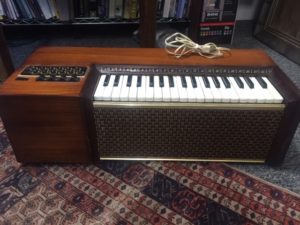 JS sent a photo of a Thomas Organ Company model C-12 “Multi-chord” mini organ, late 1950’s, manufactured in Italy. They made this little gem for tabletop performances, but you can also mount it on pole legs. It features 15 black keys, 22 white keys, and 12 bass chord buttons in the major key, with a fun volume/vibrato finger slide, and since it uses electricity, an off-on switch. At 27 inches long, 11.5 inches wide, and 8 inches tall, it runs on 117 volts, 60 cycles, and 25 watts, weighing a hefty 27 lbs, you need a strong table top.
JS sent a photo of a Thomas Organ Company model C-12 “Multi-chord” mini organ, late 1950’s, manufactured in Italy. They made this little gem for tabletop performances, but you can also mount it on pole legs. It features 15 black keys, 22 white keys, and 12 bass chord buttons in the major key, with a fun volume/vibrato finger slide, and since it uses electricity, an off-on switch. At 27 inches long, 11.5 inches wide, and 8 inches tall, it runs on 117 volts, 60 cycles, and 25 watts, weighing a hefty 27 lbs, you need a strong table top.
Your smart phone can do everything, and more, this organ can do. But your phone can’t look this cool. A midcentury cool, with a real walnut veneer and a gold flecked knobby speaker cover. The blocky console line is also cool, and this baby is in perfect shape. I heard a recording of the sound, and it is funky and LOUD. Hard to haul around, but very retro.
Certain hipsters like this kind of thing, as they like the Hohner, for its droning and depressing ‘chord’ organ tone. Think of the bass accompaniment buttons on an accordion with vibrato. Since the label says Thomas Organ Co., of Sepulveda, California, we know this organ dates from after 1956, when the Thomas Organ Co. moved from Canada.
I’m familiar with the tradition of an organ in the home, as my parents forced me to practice upon such a thing. Back when I took piano lessons in Deerfield, Illinois, my father felt a young woman should possess a skill to bring her household pin money after she married. So he bought a home organ so one day I might play at weddings and church services. In those days an organ in a Middle American home wasn’t by any means unusual, nor my father’s sentiment.
Our organ in Deerfield, a massive affair, took up a large swath of our green and orange living room. But tabletop instruments like JS’s represented significant technological advances, such as solid-state electronics, and a famous low-slung console. Our beast consisted of a double 61 note pair of manuals and a 32 note pedal board. The Lawrence Welk Show featured an organ like ours, which Thomas Organ Co. later christened the “Lawrence Welk.” They made a lot of money off that model, as well as the one played by Lucille Ball in The Lucy Show. Middle America developed a need for a home organ. Today traveling around as an appraiser I see many of these that are not worth much. Some notable exceptions exist, so research the hipster and retro musical instrument market values.
Thomas Organ Co.
Right about the time the Thomas Organ Co. marketed JS’s little organ, the company reached its height. They imported the Vox Combo, manufactured the Moog Synthesizer, and imported small, portable organs like JS’s from Italy, via the Italian entrepreneur Ennio Unchini. Thomas Organ Co.’s president Joe Benaron wished to consolidate UK and US Vox production into one plant in Pescara, Italy, naming it JEN after an amalgamation of those two first names, Joe and Ennio.
Hip musicians know of JEN for their famous Wah Wah pedals and the Thomas Crybaby pedals which pioneered the notorious Wacka Wacka funk style rhythmics. People pay a lot for these today.
You may wonder why home organs became popular in the mid-20th century. Yes, the most collectible of all the organs, for its great space age “look,” is the Thomas 2001 organ from 1976. Look this up if you want a retro treat. In fact, home organs became popular 100 years before the company conceived that model. The Thomas Organ Co. was founded in 1875 to manufacture pipe organs, and then home pump organs. Those gingerbread affairs used for hymn singing in the front parlor in the late 19th century aren’t worth much today. Americans shelled out money for home organs way before the early 1950’s when the electronic organ was invented. I know my family saved for months to afford our organ, worth the cost of hauling it away today.
JS, the market finds your “Multi-chord” desirable today because it works well and projects a vintage “analogue sound.” You make me feel old when you say that word analogue. The instrument is worth $275.